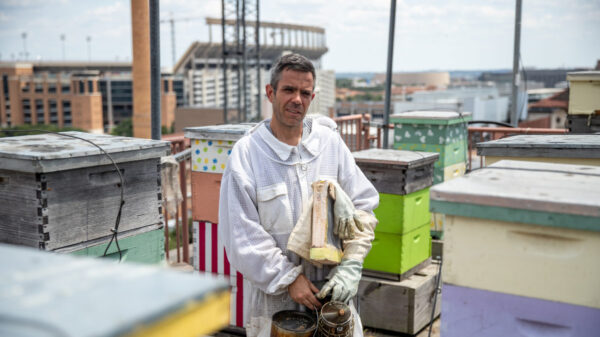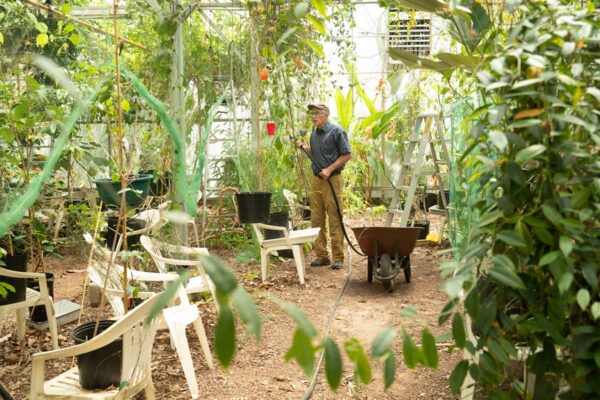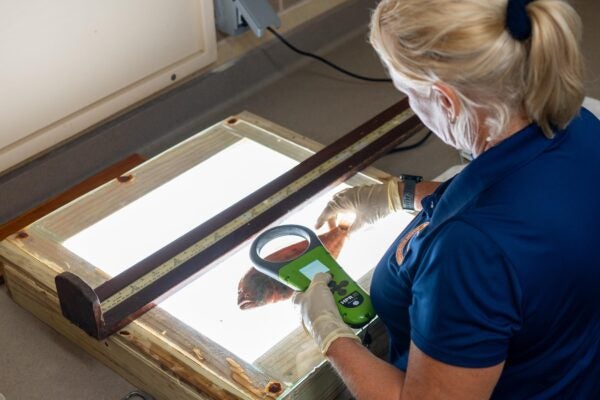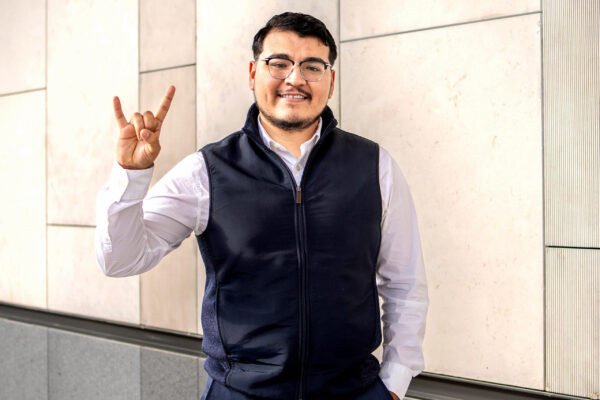Colorful work
Lawrence Gilbert, professor of integrative biology, director of the Brackenridge Field Laboratory and self-described “childhood naturalist,” began his career researching the coevolved traits — how species influence one another’s evolution — of a variety of insects and plants.
Although he works with a diversity of insects, he says butterflies hold a special place in his heart. He has studied the genetics of their wing color patterns, such as how different coexisting species develop seemingly identical patterns that warn off predators such as birds and lizards.
“If you transport me blindfolded to anywhere in South America, I can tell you where I am within a few hundred miles by looking at wing patterns of local Heliconius butterflies,” Gilbert says as he gently picks up a spotted butterfly in one of his campus greenhouses, on the roof of the J.T. Patterson Laboratories Building.
Gilbert’s fascination with butterflies began when he was a child, but he says he never thought of it as more than a hobby.
“I found a caterpillar on a plant in the pasture behind the house, raised it up and a big swallowtail butterfly came out,” Gilbert says. “I was hooked on collecting butterflies in school, but I never thought of it as something that would be a career.”
Gilbert came to The University of Texas at Austin in 1961 as a freshman biology major. He joined the faculty in 1971.
Through his work on the genetic interactions between species in his greenhouses, including at the Brackenridge Field Lab, Gilbert says he is able to provide the materials necessary for other research projects around the world.
“I can raise everything,” Gilbert says. “They’re always writing me: ‘Can we get this kind of plant?’ or ‘Can we get this stock of butterfly?’”
Gilbert says most of his current research deals with invasive species — such as imported fire ants and certain African grasses — that are overwhelming habitats in Texas.
Working with his butterflies, he deals with natural predators such as wasps that control butterflies and moths.
“Tiny parasitoid wasps no bigger than a period in a sentence get in through vents and fans and lay eggs in butterfly eggs,” he says. “As many as 10 to 15 wasps can emerge from a butterfly egg just over 1 millimeter tall.”
Undergraduate students and research assistants help Gilbert collect butterfly eggs before wasps can get to them to help keep up the population for research.
Although most of his funded work these days doesn’t involve butterflies, he still maintains his greenhouses and helps students who have an interest in research involving butterflies, passion vine plants and other natural wonders.
“As far as the butterfly research goes, a lot of that is keeping my pure passion for working with that system going and helping anybody else who wants to work on fundamental questions like how novel wing patterns evolve,” he says.

Big buzz
Eli Powell, a research associate in the Integrative Biology Department, says the solitary aspect of butterflies is completely different from the social behavior found in beehives.
“It’s social in that it’s built up of this insect society,” Powell says. “Some people have called bee colonies ‘super organisms’ because they function in the way an organism would. All of the workers in the hive do tasks like organs in an organism. They regulate the temperature. They regulate the nutrients coming in and going out. And then there’s the queen, who is the sole ovaries of the superorganism.”
Powell studied biology at the University of Utah and graduated in 1996. He currently works for professor Nancy Moran, who researches the bacteria that live inside insects, including bees. Powell manages the undergraduate students who work in the lab with co-lab manager Kim Hammond, making sure lab procedures are followed and that things run smoothly.
Like Gilbert, Powell says he became fascinated by biology at an early age. At UT, he is able to do research both outside and in the lab.
“I liked the idea of being some kind of naturalist and being outdoors,” Powell says. “Which some people get to do in science these days, but it’s kind of rare. We mostly work in labs and work with DNA sequences. I feel lucky, being in a job where I get to spend some time outdoors with actual organisms as well as some time in the lab and doing analytic stuff.”
Powell says he and his team study common bacteria found in bees all over the world and have found that some play a large part in helping bees digest food and get nutrients from nectar and pollen.
“We’ve also found that some of these bacteria play big roles in the immunity of bees against pathogens,” Powell says. “Some broader ideas that this research might look at some day are that human beings have this microbiota in their guts, and it might be similar to a bee gut microbiome.”
For the next couple of years, Powell says that his team has a grant to look at the influence of chemicals used in agriculture on the bee gut microbiome. This includes looking at pesticides, herbicides, antibiotics, different dietary supplements and various probiotics that contribute to the overall threat to bees.
“The common story that’s out there is that bees are under threat from a variety of things, like climate change to pesticides to the loss of habitat,” Powell says. “(We will) just continue doing research to see how broad those impacts are and if there’s any way to help the bees defend themselves against those kinds of threats.”
Powell says several graduate students and postdoctoral researchers continue working with bees after being introduced to the research in his lab.
“It’s been kind of cool to see folks come through, and this will be their first exposure to bees,” Powell says. “And then they continue on and keep working with that organism and keep adding to the research and knowledge around them.”
Even though his research encompasses only a small element of the bee population, Powell hopes it positively affects bees in a greater way.
“There are aspects of what we do that may help bee populations one day, I hope,” Powell says. “A big chunk of what we’re doing is just basic science, just trying to understand things and how they work out there in the natural world. That’s kind of the first step that comes before the development of strategies for conservation.”




